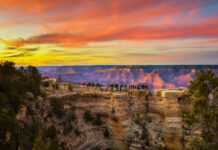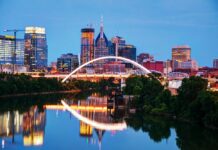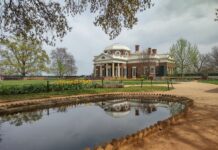On our first morning at Fort Lewis Lodge, we threw on sweat shirts, left the charming little log cabin where we’d spent a restful night— at least until our 10-month-old woke us at 6:30 a.m.— and followed the path marked Cowpasture River. Any negative associations conjured by the river’s name (I don’t automatically connect cow pastures with sparkling clear waters) dissipated a few minutes later when we arrived at its banks. In the foreground, sunlight glittered on water trickling over rocks while in the background rose a sheer wall of rock. Around us was the lush river valley, acres of fields dotted with grazing cows and, in the distance, the green peaks of the Allegheny Mountains.
“Hello there,” a voice called from upriver. One of the guests we’d met at dinner the evening before was standing in waders casting her fishing line in an arc over her head as the inn owners’ dog splashed nearby.
“Is it just me,” I said to my husband as I waved back, “or do you feel like we’re on the set of ‘A River Runs Through It’?”
 It wasn’t just the river and the fly-fishing that called up memories of the movie based on the autobiographical novel by Montanan Norman Maclean. Since we’d arrived in Bath County, Va., I’d felt like we were in the West. The country roads we’d driven after leaving Interstate 81 led up mountains and down into valleys, delivering us through thick stands of trees— almost 90 percent of Bath County is forest— from one panoramic view to the next. We passed few cars (less than 5,000 people live in the county and there are no incorporated towns) and not a single traffic light. We breathed in clean, fresh air. We looked up at a sky that was big and blue.
It wasn’t just the river and the fly-fishing that called up memories of the movie based on the autobiographical novel by Montanan Norman Maclean. Since we’d arrived in Bath County, Va., I’d felt like we were in the West. The country roads we’d driven after leaving Interstate 81 led up mountains and down into valleys, delivering us through thick stands of trees— almost 90 percent of Bath County is forest— from one panoramic view to the next. We passed few cars (less than 5,000 people live in the county and there are no incorporated towns) and not a single traffic light. We breathed in clean, fresh air. We looked up at a sky that was big and blue.
Most out-of-towners come to Bath County, located about 200 miles from Baltimore, to stay at The Homestead, the renowned resort located in the town of Hot Springs, and perhaps take in a concert at the equally renowned Garth Newel Music Center. But we were looking to get away from big groups of people and truly relax in nature, albeit without having to rough it. That’s exactly what John and Caryl Cowden offer at Fort Lewis Lodge.
Natives of Ohio, the couple came to Bath County in 1978 to help farm the 3,200-acre property that John’s father had bought after being swept away by the beauty of the area on a trip to buy a bull. Even though John had agricultural school training and wanted more than anything to be a farmer— and even though the property had been a farm since Revolutionary War days— the Cowdens learned after five years that they couldn’t make a living solely by farming. So, while raising three young children, running a cow/calf/cattle operation and growing row crops, the Cowdens renovated Lewis Mill— a circa-1850 grist mill on the property— into a big dining room and kitchen, and built a two-story lodge, which is attached to a 1930s-era salt-glazed tile silo that houses three in-the-round rooms reached by a spiral staircase. They opened for business in 1989 and since then have added a circa-1900 five-bedroom house on a upper tract of land known as Riverside House, and erected three one-bedroom historical log cabins, all of which were painstakingly dismantled, moved to the property and put back together again.
All of the structures offer comfortable and charming rooms that are, thankfully, more Shaker chic than country kitchen, and offer modern amenities like air-conditioning and wireless Internet. We were lucky enough to stay in the Tall Timbers cabin, which has a wet bar (with a mini-refrigerator that’s a good place to store fixings for a picnic lunch), a wooden farm table and a daybed on the first floor and a roomy bedroom and bath on the second floor. A sliding glass door leads from the bedroom to a balcony with views of the valley.
The buildings that comprise Fort Lewis Lodge house 19 units total in a combination of rooms and suites, and, from serving as general contractor to sawing logs, John Cowden has been intimately involved in their creation. “I love farming, but I found something I love even more,” he says. “Building.” His most recent creation is a covered pavilion that he calls a “large outdoor living room.” There’s a ping-pong table, comfy chairs and a large stone fireplace that John lights every night. Sometimes there are informal gatherings of bluegrass musicians. “When we run into somebody and they’re willing to play, we just see what happens,” he says.
Six years ago, he gave up farming completely and now the land serves multiple uses. “We use the natural beauty for hospitality. We lease the land to farmers, do timber harvesting when the [U.S.] Forest Service recommends it and lease the land for hunting,” John says. “Everything overlaps somewhat seamlessly.”
It’s pretty rare to find a place that suits families as well as couples and single travelers— and suits those who want to “do” as well as those who want to “be.” Fort Lewis Lodge manages to be that place. With a maximum of just 45 guests spread out over 3,200 acres, you can get away from everyone and everything if you like. You can hike— the hickory loop trail travels up the backside of that wall of rock we saw on the far side of the river. You can borrow the lodge’s mountain bikes and cycle along quiet country roads or strike out for more adventurous terrain— John will orient guests with a map. Or you can try your hand at fishing trout or native rockfish in the river.
Those in need of R and R can simply stroll the grounds or loll on the bench overlooking the little pond outside Lewis Mill. That’s the tact we took, though had it been a bit warmer, you can bet we would’ve spent hours at the swimming hole, a 5-foot-deep pool of clear blue water located at a bend in the river 200 yards east of the lodge. The Cowdens have built a little sundeck there and provide inner tubes and kayaks for paddling around in the relatively tame white water. That swimming hole is the kind of thing that makes you happy to be alive, and it makes a stay at Fort Lewis Lodge a great alternative to a weekend at a hot, crowded beach. I can’t imagine a nicer way to spend a summer day or two— or a better way to work up a healthy appetite.
“Eating is kind of a centerpiece of the Fort Lewis experience,” John Cowden told us when we arrived. That wasn’t news to me. A friend had visited the lodge a few weeks before, and made me a list of what she’d eaten for dinner. One night it was grilled pork tenderloin with barley and wild rice, pasta salad with dill and zucchini, glazed carrots, green salad and apple cake. The next night it was grilled beef tenderloin, crab cakes, stewed tomatoes and pumpkin muffins.
So when we arrived at Buck’s Bar (Buck is John Cowden’s nickname) for the evening social hour, a glass of local Dominion beer only whetted our already hearty appetites. We were among the first folks at the buffet table when John rang the dinner bell at 7:30 and we weren’t too proud to go back for seconds of grilled salmon with dill sauce, corn pudding, sweet potato casserole, snap peas and strawberry shortcake. Most of the vegetables were grown locally and all of the breads and desserts were made from scratch. “Everything is made to go together,” says Caryl Cowden. “It’s like you’re going to a dinner party.” Her simple, satisfying American cuisine has earned such a reputation that folks drive out of the way to dine at the lodge even if they aren’t staying for the night.
 After dinner, we strolled back to our cabin, put our baby to sleep and I immediately crawled into the cozy queen-size sleigh bed while my husband soaked in the outdoor hot tub and climbed the steps to the star deck. Even though the mountain air was chill, we left the sliding glass door open so we could listen to the night sounds.
After dinner, we strolled back to our cabin, put our baby to sleep and I immediately crawled into the cozy queen-size sleigh bed while my husband soaked in the outdoor hot tub and climbed the steps to the star deck. Even though the mountain air was chill, we left the sliding glass door open so we could listen to the night sounds.
That morning, after our walk along the river and a delicious breakfast— quiche, hash browns, homemade muffins— we got back in the car. We had that feeling you get when you’ve really relaxed, the feeling of having been away for weeks even though it has only been a day or two. Thankfully, we still had one more day in Bath County, so instead of heading back east toward Staunton, where we’d spent a fun afternoon touring the town and the renowned Blackfriars Playhouse, we headed farther west on Route 39. Most of the way up Warm Springs Mountain, we pulled over to take in the view of the 9,000-plus acres of forest owned by the Nature Conservancy. Coming down the other side of the mountain dropped us nearly at the doorstep of Jefferson Pools.
If you’re looking for a luxurious spa experience, your best bet is to head five miles down the road to The Homestead. But if you’re looking for a historical spa experience, Jefferson Pools is the real deal— the octagonal, domed wooden building that houses the men’s pool house is considered the oldest spa structure in the United States. It opened to the public in 1761 and remains pretty much the same as it did when 75-year-old Thomas Jefferson took the mineral waters to soothe his rheumatism.
 Leaving my husband to amuse our daughter on the lawn, I paid $17 to a gal at the entrance of the ladies pool house, which was built in 1836. She showed me to one of the dressing rooms located around the perimeter of the pool, where I shed my clothes and considered donning one of the bathing suits provided (they were sewn by a local woman years before) before deciding to stick with my own. I could have gone in the buff— since the men’s and women’s facilities are separate, clothing is optional— but I was more interested in coverage than exposure, especially after all that delicious food at Fort Lewis Lodge.
Leaving my husband to amuse our daughter on the lawn, I paid $17 to a gal at the entrance of the ladies pool house, which was built in 1836. She showed me to one of the dressing rooms located around the perimeter of the pool, where I shed my clothes and considered donning one of the bathing suits provided (they were sewn by a local woman years before) before deciding to stick with my own. I could have gone in the buff— since the men’s and women’s facilities are separate, clothing is optional— but I was more interested in coverage than exposure, especially after all that delicious food at Fort Lewis Lodge.
I left the dressing room and stepped down into the pool to find the water warm— 98 degrees (as opposed to 115 degrees up the road in Hot Springs)— and bearing the scent of sulfur like any good natural spring should. As I floated on my back, staring up at the round hole in the domed roof, every so often a bubble rose up from the rock floor. Four women of a certain age, friends who visit the pools every year, relaxed at the edge of the pool. Since the posted rules say “no loud talking,” we didn’t disturb each other’s peace.
My $17 entitled me to an hour-long soak in the pool, but after about 20 minutes, I was itching to do more exploring. A short drive away, while scoping a spot for our picnic lunch, we happened upon Hidden Valley Bed and Breakfast. Even more secluded than Fort Lewis Lodge, the inn is housed in an 1851 plantation home called Warwickton, which is now owned by the Forest Service. Proprietor Pam Stidham showed us around the property, which features historical slave cabins, a vast garden and a “summer kitchen” that was one of the sets for the movie “Sommersby.” On our way back to the picnic area, we chatted with a fisherman who’d just caught a few trout off the one-lane bridge that leads to the inn. Under the bridge rush the waters of Jackson River, one of the Top 100 trout locations in the nation.
Late afternoon found us pulling off Route 220 into Warm Springs, a charming hamlet with a picturesque courthouse and miniature library and post office strung out along a hill leading to the Inn at Gristmill Square. The inn is actually a collection of five 19th-century buildings housing 17 rooms and suites, and our room was one of seven housed in a former hardware and feed store. Like all of the accommodations, it was furnished with a mix of antiques and modern amenities: a king-size bed, a pair of wing-backed chairs, a fireplace with a mantel hand-carved by Hessians, a soaking tub and a flat-screen TV.
 Just across the central stone patio was the Waterwheel Restaurant, which occupies the former grist mill of the inn’s name. The building is a national historical landmark and the water wheel remains, as does the millstone and the grain elevator. “The wheat still comes out of the walls,” says Bruce McWilliams, who runs the inn with his mother, Janice. “Every time we have a big wind storm, we see it.”
Just across the central stone patio was the Waterwheel Restaurant, which occupies the former grist mill of the inn’s name. The building is a national historical landmark and the water wheel remains, as does the millstone and the grain elevator. “The wheat still comes out of the walls,” says Bruce McWilliams, who runs the inn with his mother, Janice. “Every time we have a big wind storm, we see it.”
In the restaurant itself, tables are set down among various milling contraptions, and we enjoyed imagining the function of each as we tucked into our dinner there. Before we headed back to our room, we peeked into the bar, which occupies the home of the miller who once ran the grist mill, and walked into the basement to see the flywheel, which stands next to a wine cellar where guests can choose a bottle for their tables.
In the morning, we savored the continental breakfast delivered to our room in a picnic basket and moseyed along the gurgling river before packing up and heading back over the mountain toward the interstate. As we drove away, I thought about what Bruce McWilliams had said when I told him how much I liked Bath County, and how much I wished it were two hours from Baltimore instead of five. If that were the case, he told me, it would be much more crowded, and much less wonderful. “Bath County is a little hard to get to,” he’d said. “It takes a commitment to get here, which is part of the charm.”
STAY
> Fort Lewis Lodge, 603 Old Plantation Way, Millboro, Va., 24460, 540-925-2314, http://www.fortlewislodge.com. Rates from $215/night, including dinner and breakfast for two guests.
> The Inn at Gristmill Square, 124 Old Mill Road, Warm Springs, Va., 540-839-2231, http://www.gristmillsquare.com. Rates from $110/night.
> Hidden Valley Bed and Breakfast, 2241 Hidden Valley Road, Warm Springs, Va., 540-839-3178, http://www.hiddenvalleybedandbreakfast.com. Rates from $120/night.
PLAY
> Jefferson Pools, Warm Springs, Va., 540-839-7741, http://www.thehomestead.com/spa_at_the_homestead
> Blackfriars Playhouse, American Shakespeare Center, 10 S. Market St., Staunton, Va., 540-851-1733, http://www.americanshakespearecenter.com




